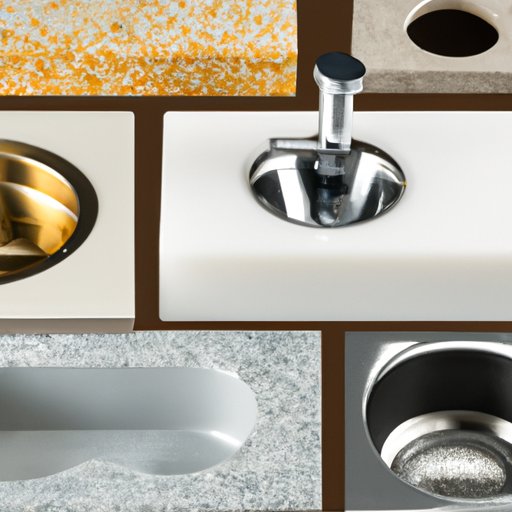Introduction
When it comes to choosing the right kitchen sink material for your home, there are a lot of factors to consider. From durability and cost to maintenance requirements and style, each material has its own advantages and disadvantages. In this article, we will take a look at the pros and cons of different kitchen sink materials so that you can make an informed decision when selecting the right one for your home.
Comparison of the Pros and Cons of Different Kitchen Sink Materials
There are a variety of materials to choose from when it comes to selecting a kitchen sink. Each material offers its own unique benefits and drawbacks, so it’s important to carefully weigh all of your options before making a final decision. Let’s take a look at some of the most popular materials on the market:
Stainless Steel
Stainless steel is a popular choice for kitchen sinks due to its durability and affordability. It is also resistant to stains and rust, making it easy to clean and maintain. However, stainless steel can be noisy and prone to scratches, which can affect its overall appearance.
Granite and Quartz
Granite and quartz are two of the most durable materials available for kitchen sinks. They are both heat-resistant and scratch-resistant, making them ideal for busy kitchens. However, these materials can be expensive and difficult to install.
Porcelain
Porcelain is another popular option for kitchen sinks. It is relatively inexpensive and easy to install, and it is also resistant to heat and staining. However, porcelain is more prone to cracking than other materials, so it may not be the best choice for heavily used kitchens.
Copper
Copper kitchen sinks have become increasingly popular in recent years due to their natural beauty. Copper is also antimicrobial, meaning it won’t harbor bacteria like some other materials. However, copper is more expensive than other materials and requires regular maintenance to keep it looking its best.
Cast Iron
Cast iron is a durable material that is well-suited for kitchen sinks. It is heat-resistant and heavy, so it won’t move around when installed correctly. However, cast iron can be difficult to install and is prone to rusting if not properly maintained.

Benefits of Installing a Stainless Steel Kitchen Sink
Stainless steel is one of the most popular materials for kitchen sinks due to its durability, cost-effectiveness, and ease of cleaning. Stainless steel is highly resistant to corrosion, meaning it won’t rust or stain over time. This makes it an ideal choice for busy kitchens, as it can withstand heavy use without showing signs of wear. Additionally, stainless steel is relatively inexpensive compared to other materials, making it an affordable option for many homeowners.
Cleaning a stainless steel sink is also a breeze. Most dirt and grime can be wiped away with a damp cloth and mild detergent. For tougher stains, a scrub brush can be used to remove any stubborn residue. This makes stainless steel a great choice for those who want a low-maintenance sink.

A Look at the Durability of Granite and Quartz Kitchen Sinks
Granite and quartz are two of the most durable materials available for kitchen sinks. These materials are strong and heat-resistant, making them ideal for busy kitchens. Additionally, granite and quartz are scratch-resistant, meaning they will stay looking new for years. The only downside to these materials is that they can be quite expensive.

The Advantages and Disadvantages of Porcelain Kitchen Sinks
Porcelain is a popular choice for kitchen sinks due to its affordability and easy installation. It is also resistant to heat and staining, making it a great option for busy kitchens. The downside to porcelain is that it is more prone to cracking than other materials, so it may not be the best choice for high-traffic areas.
Understanding the Benefits of Copper Kitchen Sinks
Copper kitchen sinks are becoming increasingly popular due to their natural beauty. Copper is also naturally antimicrobial, meaning it won’t harbor bacteria like some other materials. Additionally, copper is relatively easy to maintain and doesn’t require much upkeep. The downside to copper is that it is more expensive than other materials and requires regular maintenance to keep it looking its best.
An Overview of Cast Iron Kitchen Sinks
Cast iron kitchen sinks are a popular choice due to their heat retention and weight. Cast iron is extremely durable and can last for decades with proper care. However, cast iron is also prone to rusting if not properly maintained, so it is important to keep up with regular cleaning and maintenance.
Conclusion
When it comes to selecting the right kitchen sink material for your home, there are a variety of factors to consider. From durability and cost to maintenance requirements and style, each material has its own unique set of advantages and disadvantages. In this article, we have taken a look at the pros and cons of stainless steel, granite and quartz, porcelain, copper, and cast iron sinks so that you can make an informed decision when selecting the right material for your kitchen.
After considering all of the factors, our final recommendation is to go with a stainless steel sink. Stainless steel is highly durable, cost-effective, and easy to clean, making it the perfect choice for busy kitchens. However, if you’re looking for something more luxurious, then you may want to consider granite or quartz. Whichever material you choose, make sure it fits your needs and budget.


